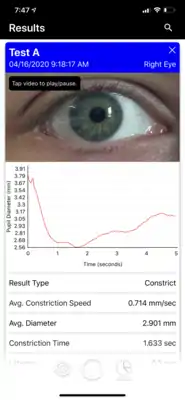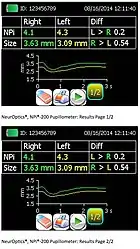Pupilometer
Pupilometer, also spelled pupillometer, is a name for two different devices—one used to measure the pupillary light reflex, and the other used in ophthalmology, which measures the distance between pupils through visual stimuli.[1]
Automated Pupillometry


An automated pupillometer is a portable, handheld device that provides a reliable and objective measurement of pupillary size, symmetry, and reactivity through measurement of the pupillary light reflex. Independent of examiner, an automated pupillometer eliminates variability and subjectivity, expressing pupil reactivity numerically so that both pupil size and reactivity can be trended for changes, just like other vital signs. An automated pupillometer also provides a reliable and effective way to quantitatively classify and trend the pupil light response.[2][3][4][5]
Using automated pupillometers and algorithms, such as Reflex's Reflex Score or NeurOptics' Neurological Pupil index (NPi), can offer a consolidated parametric approach to mitigate subjectivity.[6] However, the calculation for the Neurological Pupil index (NPi) remains undisclosed by NeurOptics. Reflex, manufactured by brightlamp Inc. and available on the iOS App Store, offers the benefit of not requiring infrared light to conduct the same measurements using only an iPhone or iPad.[7] Reflex Score's calculation method has been disclosed by brightlamp, Inc. so clinicians and medical professionals can directly see how specific parameters impact the Reflex Score.
The most effective way to use an automated pupillometer is to establish the earliest possible baseline measurement when the patient is admitted into the critical care unit or emergency department, and then trend for changes over time.
Pupillary distance measurement in ophthamology
In the most common sense, a pupilometer is a tool for measuring pupillary distance (PD). It is used for fitting eyeglasses so that the lenses are centered in the visual axis. This is the most common nomenclature. It may also be used to verify a PD measurement taken from a millimeter ruler placed across the bridge of a patient's nose for distance and near focus.
Pupils are consisted of many parts, so it’s hard to determine where. There are a variety of ways of measuring one's pupil distance. Historically a ruler is used by optometrists. State of the art are video centration devices which provide higher accuracy and repeatability compared to manual measurements.[8] The accuracy is especially a concern for progressive lenses where small deviations severely reduce the performance of the lens. In addition to having it measured when one visits an optometrist, there are a variety of mobile phone apps and web apps that a person can use. The apps are available for the Android and IOS phones and tablets. The web app is used by a variety of online sellers of eyeglasses.[9][10][11][12] In order to use the phone app or web app, a camera and a credit card with a magnetic strip are needed to assist in the measuring processes.
Pupil response
Alternatively, a pupilometer is a type of pupil response monitor — a monocular device measuring the amount of dilation of the pupil in response to a visual stimulus.
In ophthalmology, a pupillary response to light is differentiated from a pupillary response to focus (i.e. pupils may constrict on near focus, as with the Argyll Robertson pupil) in the diagnosis of tertiary syphilis. Although a pupillometer can be used, the diagnosis is often made with a penlight & near-point card
The extent of dilation of the pupil in the eye could be an indicator of interest and attention.[13] Methods of reliable measurement of cognitive load, such as the dilation or constriction of the pupils, are used in marketing research to assess the attractiveness of TV commercials. Dilation of the pupils reflects an increase in mental processes, whether it be attentiveness, or psychomotor responsiveness.[14] The pupil response has also been found to reflect long-term memory processes both at encoding, predicting the success of memory formation,[15] and at retrieval reflecting the operation of different recognition outcomes.[16]
References
- Lussier, Bethany L.; Stutzman, Sonja E.; Atem, Folefac; Venkatachalam, Aardhra M.; Perera, Anjali C.; Barnes, Arianna; Aiyagari, Venkatesh; Olson, DaiWai M. (December 2019). "Distributions and Reference Ranges for Automated Pupillometer Values in Neurocritical Care Patients". The Journal of Neuroscience Nursing: Journal of the American Association of Neuroscience Nurses. 51 (6): 335–340. doi:10.1097/JNN.0000000000000478. ISSN 1945-2810. PMID 31688284.
- Olson D, Fishel M. The use of automated pupillometry in critical care. Critical Care Nursing Clinics North America. 2015;28(2016):101-107.
- Meeker M, Du R, Bacchetti P, et al. Pupil examination: validity and clinical utility of an automated pupillometer. J Neurosci Nurs. 2005;37:34–40.
- Chen J, Gombart Z, Rogers S, Gardiner S, Cecil S, Bullock R. Pupillary reactivity as an early indicator of increased intracranial pressure: the introduction of the neurological pupil index. Surg Neurol Int. 2011;2:82.
- Du R, Meeker M, Bacchetti P, Larson M, Holland M, Manley G. Evaluation of the portable infrared pupillometer. Neurosurgery. 2005 57:198–203.
- Olson, D.; Stutzman, S; Saju, C; Wilson, M; Zhao, W; Aiyagari, V (2016). "Interrater Reliability of Pupillary Assessments". Neurocritical Care. 24 (2): 251–7. doi:10.1007/s12028-015-0182-1. PMID 26381281.
- Nichols, Aaron (2020). "Objective Measurement of Sustained Pupillary Constriction: A Pilot Study Using an App-Based Pupilometer". Vision Development and Rehabilitation. 6: 57 – via COVD.
- In German: Moderne Videozentriersysteme und Pupilometer im Vergleich, Teil 1, PD Dr. Wolfgang Wesemann, DOZ 6-2009 Archived 2015-09-24 at the Wayback Machine
- The Pupil Meter
- The Pupil Meter Archived 2013-06-14 at the Wayback Machine
- "The Pupil Meter". Archived from the original on 2016-08-04. Retrieved 2014-10-27.
- The Pupil Meter
- Hess, Eckhard H.; Polt, James M. (5 August 1960). "Pupil Size as Related to Interest Value of Visual Stimuli". Science. 132 (3423): 349–50. doi:10.1126/science.132.3423.349. PMID 14401489.
- "Dr. John Andreassi, editor of International Journal of Psychphysiology, with guest editor Eric Granholm "Pupillometric Measures of Cognitive and Emotional Processes"" (PDF). Retrieved 2007-07-16.
- Kafkas, A., & Montaldi, D. (2011). Recognition memory strength is predicted by pupillary responses at encoding while fixation patterns distinguish recollection from familiarity. The Quarterly Journal of Experimental Psychology, 64(10), 1971–1989. http://www.tandfonline.com/doi/abs/10.1080/17470218.2011.588335
- Kafkas, A., & Montaldi, D. (2012). Familiarity and recollection produce distinct eye movement, pupil and medial temporal lobe responses when memory strength is matched. Neuropsychologia, 50(13), 3080–93. doi:10.1016/j.neuropsychologia.2012.08.001